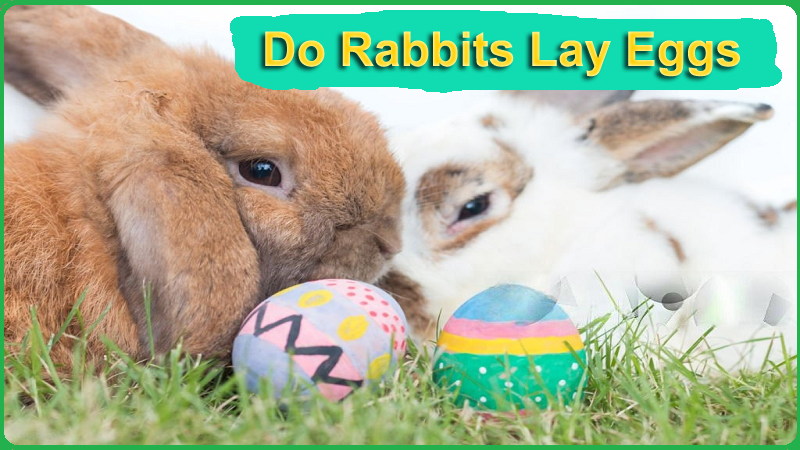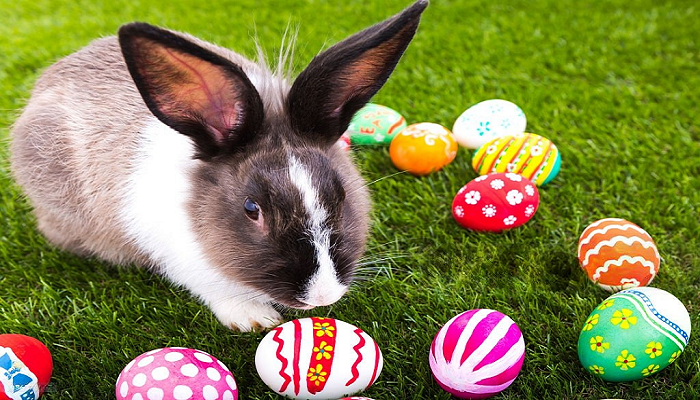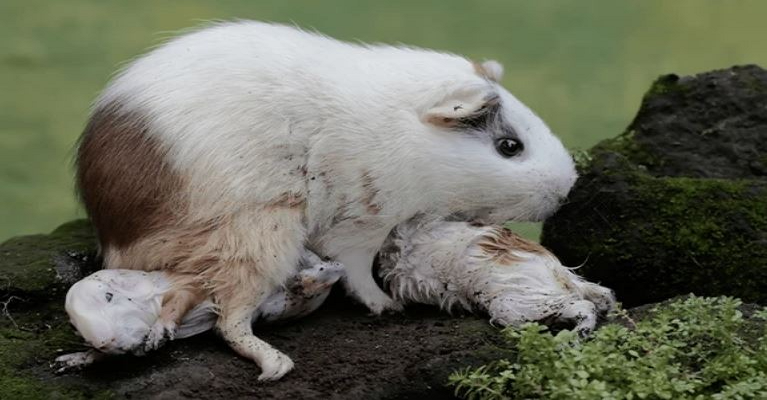Most of rabbit owners have fully wondered about ‘Do Rabbits Lay Eggs?’ The straight ward answer is ‘NO‘; they don’t lay eggs. Rabbits come in the placental mammals that mean they give birth to live young. However, this query has been persisted since the years, and it has even become a trending topic on search engines.
Till now, many people wonder how rabbits give birth. But, some people may seem like a strange question. These myths regarding bunnies still carry on to this day.
From this article, we will give clarity about whether bunnies lay eggs or give birth. As well as, you will also get to know about distinctive characteristics of their reproductive process. Keep reading it to obtain complete information about rabbit lays eggs.
Understanding Rabbit Reproduction
Rabbits are well-known mammals, who have prolific breeding capabilities. Unlike the myth that rabbits do lay eggs or they give birth to live young after a gestation period.
Sexual Maturity and Anatomy
Rabbits reach sexual maturity as soon as, their time period around 3-4 months for females (does) and 4-6 months for males (bucks). Female rabbits have a bicornuate uterus. It helps to multiple embryos from different matings to develop simultaneously. Males generate the sperm continuously after maturity.
Mating and Induced Ovulation
Rabbits don’t have a regular estrous cycle. They do induce ovulators that mean the act of mating triggers egg release. Mating behavior makes the courtship rituals where the male courts the female by circling and nuzzling. Copulation get quick and successful mating stimulates ovulation.

Gestation and Nesting
The gestation time period for rabbits is approximately 28-31 days. At the end of this period, the female makes a perfect nest by using hay, leaves, and her own fur. She gives birth to several kits, it may be four to twelve.
Neonatal Care
When kits get born, then are blind, deaf, and hairless, so they require the significant care. The mother nurses them once or twice daily with nutrient-rich milk. Kits do development quickly. In the first week, they open their eyes and growing fur and starting to eat solid food by three weeks. They are nursed of mother’ milk by six to eight weeks.
Postpartum Estrus
Female rabbits are capable to conceive again almost immediately after giving birth due to postpartum estrus. So, they can produce multiple litters annually.
Misconceptions about Rabbits and Egg-Laying
One prevalent and persistent myth is that rabbits lay eggs. This misconception is deeply ingrained in popular culture, particularly around the Easter holiday. It entirely unfound when examined through the lens of biology.
Also Read: Do Rabbits Blink Their Eyes? Bunny Eyelid Behavior
Origins of the Myth about Rabbits Egg-Laying
Easter Traditions
The relation established between rabbits and eggs originates from Easter traditions. As folklore figure, the Easter Bunnies deliver eggs to children. As per pagan cultures, rabbits and hares denominated to fertility and rebirth. The Christian celebration of Easter marks the Jesus’s resurrection. It coincides of these symbols to new life.
German Folklore
The specific tradition of an egg-laying hare, or “Osterhase,” originated in Germany. German immigrants brought this tradition to America in the 1700s, and evolved into the modern Easter Bunny myth.
Biological Reality about Rabbits Egg-Laying
Mammalian Reproduction
Rabbits are mammals animal. Like all mammals, they are capable to give birth to live young. A female rabbit also (does) undergo internal fertilization and gestate their offspring for about 28-31 days, then give birth to live kits.
Nesting and Birth
Prepare the nests by using fur and plant material to ensure their kits are born into a safe and warm environment. Kits are born blind and hairless, so they are totally in relying heavily on maternal care.
Why Rabbits Do Not Lay Eggs?
Rabbits haven’t ability to lay eggs because their reproductive system is designed for live births. The main difference in between mammals and egg-laying animals depends on their evolutionary adaptations and biological processes.
Also Read: Can Rabbits Climb? Fact or Fiction
Here, you will look at why rabbits do not lay eggs:
Mammalian Characteristics
Rabbits reproduce through internal fertilization, when the male’s sperm fertilizes the female’s eggs internal her body.
The fertilized eggs do implant in the uterus, where they develop into embryos. This process is totally contrasting with the external fertilization seen in many egg-laying species.
Mammals, including rabbits, give birth to live young. This is a key characteristic that it makes different them from other vertebrates like birds, reptiles, and amphibians, which lay eggs.
The gestation period for rabbits is about 28-31 days. After which the mother gives birth to fully formed, albeit underdeveloped baby.
Rabbit kits are born blind, deaf, and hairless, so requiring extensive maternal care. They rely on their mother’s milk, which is rich in nutrients, for their initial growth and development.
Evolutionary Adaptations
Mammals, including rabbits, evolved from synapsid ancestors that diverged from the reptilian line around 300 million years ago. This evolutionary path always supports to development of internal gestation and live births. Due to this, it offers the greater protection and a higher survival rate for the offspring.
Also Read: How to Keep Rabbits Nails Short Without Cutting Them? Full Guide
Giving birth to live young allows for a more controlled and protected development environment. The mother can offer the reliable temperature, nutrition, and safety from predators. This is advantageous as compared to the external environment where eggs get lay.
Biological Reality
Female rabbits have a reproductive system that give for live births. They have a bicornuate uterus that has ability to carry several embryos simultaneously. Due to this anatomy, they are totally fundamentally different from egg-laying animals. They consist the reproductive structures that are comfortable for producing and laying eggs.
Rabbits have hormonal mechanisms that regulate to reproduction, and geared to towards for maintaining pregnancy and nurturing live young. Hormones like as progesterone that are essential to gestation and preparing the body for birth and lactation.
How Do Rabbits Give Birth?
Rabbits give birth to live young through a system that enables with internal fertilization, gestation, and parturition. Mating typically occurs when a male rabbit (buck) mounts a female rabbit (doe), then male’s sperm fertilizes the female’s eggs internally.
Following successful mating, the fertilized eggs get implant in the uterus, where they develop into embryos over a gestation period of approximately 28-31 days. During this time frame, female rabbit do several physiological changes that support to grow embryos. A few days before giving birth, the pregnant doe begins to exhibit nesting behavior, preparing a warm and secure nest.
The actual process of giving birth typically occurs at night or in the early morning hours. The doe inserts into labor, then get experience of contractions that makes the delivery of the kits. Each kit is born individually, usually enclosed in a thin amniotic sac that the mother immediately breaks open to allow the kit to breathe.
After giving birth, the mother rabbit begins nursing her kits. She nurses them with nutrient-enabled milk that produced by mammary glands. The mother’s milk is beneficial for the kits’ growth and development.
Mother rabbit nurses her kits once or twice a day, with each nursing session carrying only a few minutes. Over the following weeks, the kits grow rapidly, opening their eyes, growing fur, and eventually becoming fully weaned and independent.
How Many Babies Can a Rabbit Have?
Rabbits are most eminent animal due to their prolific breeding capabilities. A single female rabbit (doe) can give birth to a large number of offspring each year due to several key factors:
Litter Size
The average litter size for rabbits ranges from 4 to 12 kits (baby rabbits). But, the exact number can vary based on the breed, age, health, and environmental of doe.
Smaller breeds of rabbits tend to have fewer kits per litter, often averaging 4 to 6. But, larger breeds can have larger litters, sometimes exceeding 12 kits.
Frequency of Litters
The gestation period for rabbits is relatively short, lasting about 28-31 days. This allows for the possibility of multiple litters per year.
Rabbits can become pregnant almost immediately after giving birth due to postpartum estrus. That means, a doe can conceive again within hours of delivering a litter.
Under optimal conditions, a doe can produce a new litter approximately every month. This means a single doe can theoretically have 12 or more litters per year, and potentially resulting in over 100 kits annually.
How Old Do Rabbits Have To Be to Breed?
Rabbits can reach sexual maturity quickly that allowing them to begin breeding at a relatively young age. Generally, most domestic rabbits can start breeding between 3 to 6 months of age. Female rabbits, typically reach sexual maturity slightly earlier than male rabbits.
Also Read: How to Play with Your Rabbit? Interactive Playtime
Smaller rabbit breeds easily tend to mature faster, often becoming sexually mature around 3 to 4 months of age. But, larger breeds may take a bit longer, reaching maturity between 4 to 6 months.
The age at which a rabbit can begin breeding also depends on health and nutrition. Well-nourished rabbits in good health will mature faster and be more capable of successful reproduction.
Environmental factors also impact on their breeding, including adequate space, reduced stress, proper care, and timely sexual maturity.
Although, rabbits can breed at a young age, but should wait until they are fully grown. For female, have a wait until they are about 5 to 6 months old. Ensure they are physically mature enough to handle pregnancy.
What Mammals Lay Eggs?
Generally, mammals are well-known for giving birth to live young, but there are a few exceptions where mammals lay eggs. These egg-laying mammals, also called the monotremes. They are belonged to the order Monotremata and found exclusively in Australia and New Guinea. Monotremes have two different species like as platypus and the echidna, also known as spiny anteaters.
Platypus (Ornithorhynchus Anatinus)
Female platypuses lay one to three eggs at a time, which are incubated in burrows. After hatching, the young platypuses are nursed by the mother. They secrete milk through mammary glands but lacks nipples.
Echidna (Tachyglossidae)
Echidnas are small, spiny mammals with long snouts and a specialized tongue for capturing insects. Female echidnas lay a single egg, which is deposited into a pouch-like structure on the abdomen. After hatching, the echidna young, known as puggles, remain in the pouch until they develop.
FAQs (Frequently Asked Questions)
What is The Gestation Period for Rabbits?
The gestation period for rabbits is approximately 28-31 days.
How Many Babies Do Rabbits Typically Have At Once?
A typical rabbit litter consists of 4 to 12 kits. But, exact number can vary depending on the rabbit’s breed and health.
At What Age Can Rabbits Start Breeding?
Most domestic rabbits reach sexual maturity between 3 to 6 months of age, but, depending on their breed and size.
How Often Can Rabbits Reproduce?
Rabbits can conceive almost immediately after giving birth due to postpartum estrus. That means, they can produce multiple litters per year, potentially having a new litter every month under optimal conditions.
Final Note
After researching and analyzing of this article, we come at rabbits don’t lay eggs. Besides, they are capable to give birth to live young through their reproductive organs, like as human being.
If this unique post is useful for you, then please share it along with your friends, family members, pet lovers or relatives over social media platforms like as Facebook, Instagram, Linked In, Twitter, and more.
Also Read: How to Stop Rabbits from Chewing? Reasons and Prevention
Do you have any experience, tips, tricks, or query regarding on this? You can drop a comment!
Have a Nice Day!






